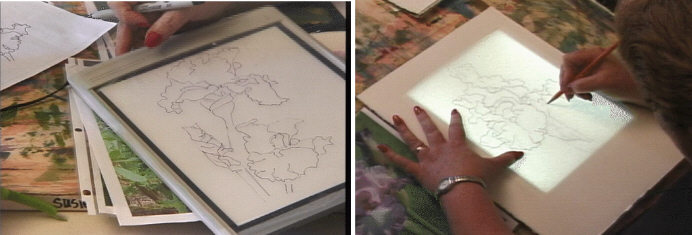
| I hope you have enjoyed my tips for transfering your drawings to watercolor paper. If you want to print and use any of my watercolor tips for personal educational non-profit purposes please read and follow my Terms and Conditions for use. Return to my list of Watercolor Tips |
| Copyright © 2007 Susie Short Studio LLC All Rights Reserved |

Transferring a simple drawing to watercolor paper
Let me start by saying I truly believe that drawing is a valuable skill to develop. Draw every
chance you get! This tip is an easy way to get your simplified image transferred to your watercolor
paper. It isn't meant to minimize the importance of learning how to draw. However when you want
to practice your lesson on painting this simple shortcut will speed up the process of outlining the
shapes so you can focus on the painting process rather than the drawing.
chance you get! This tip is an easy way to get your simplified image transferred to your watercolor
paper. It isn't meant to minimize the importance of learning how to draw. However when you want
to practice your lesson on painting this simple shortcut will speed up the process of outlining the
shapes so you can focus on the painting process rather than the drawing.
1. Start with an copy of your image. Enlarge it to the size you want to paint it.
(Try using a photo copy or a printout from you computer.)
2. Trace the shapes on clear or frosted acetate or on tracing paper.
(I like to use the overhead projector transparency film available at office supply stores.)
(Try using a photo copy or a printout from you computer.)
2. Trace the shapes on clear or frosted acetate or on tracing paper.
(I like to use the overhead projector transparency film available at office supply stores.)
3. For tracing paper, use a pencil or a permanent fine point marker. (Sharpie)
If you use the transparency film you will need to use the Sharpie permanent marker.
4. Keep the shapes simple. Don't add too much detail at this point. What you want is a basic
outline and placement of the shapes on your paper. Think about a child's coloring book.
5. Using a light box, window or glass top table with a lamp under it, place the line drawing
under the watercolor paper and trace the lines lightly.
6. This won't work for watercolor blocks so you will have to remove the paper from the block.
7. Avoid erasing as much a possible to keep from damaging the surface of the wc paper.
(I use a white plastic eraser called Magic Rub)
8. Now you are ready to paint! Clip, tape or tack the corners of your paper to a support if you
wish. I often paint on loose paper. Paint from light to dark. You can trace additional details and
add them during the painting process. Remember that the darker areas can be painted in a
lighter value and then painted or glazed over to a darker value later. Allow for complete drying
between layers.
If you use the transparency film you will need to use the Sharpie permanent marker.
4. Keep the shapes simple. Don't add too much detail at this point. What you want is a basic
outline and placement of the shapes on your paper. Think about a child's coloring book.
5. Using a light box, window or glass top table with a lamp under it, place the line drawing
under the watercolor paper and trace the lines lightly.
6. This won't work for watercolor blocks so you will have to remove the paper from the block.
7. Avoid erasing as much a possible to keep from damaging the surface of the wc paper.
(I use a white plastic eraser called Magic Rub)
8. Now you are ready to paint! Clip, tape or tack the corners of your paper to a support if you
wish. I often paint on loose paper. Paint from light to dark. You can trace additional details and
add them during the painting process. Remember that the darker areas can be painted in a
lighter value and then painted or glazed over to a darker value later. Allow for complete drying
between layers.
Have fun and enjoy the painting process. Remember to practice drawing every chance you get,
it is a skill that will enhance your creative endeavors.
it is a skill that will enhance your creative endeavors.
